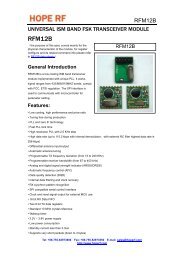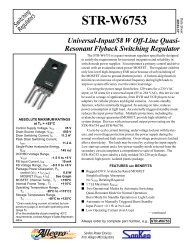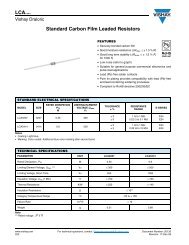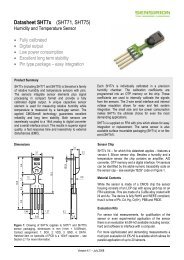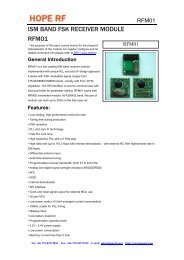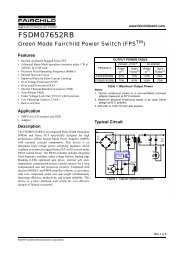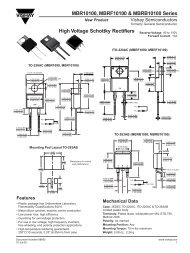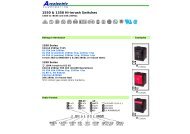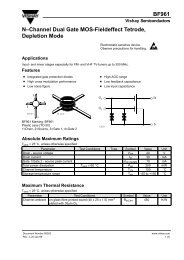LM3886 High-Performance 68W Audio Power Amplifier w Mute
LM3886 High-Performance 68W Audio Power Amplifier w Mute
LM3886 High-Performance 68W Audio Power Amplifier w Mute
You also want an ePaper? Increase the reach of your titles
YUMPU automatically turns print PDFs into web optimized ePapers that Google loves.
Application Information (Continued)<br />
LAYOUT GROUND LOOPS AND STABILITY<br />
The <strong>LM3886</strong> is designed to be stable when operated at a<br />
closed-loop gain of 10 or greater but as with any other highcurrent<br />
amplifier the <strong>LM3886</strong> can be made to oscillate under<br />
certain conditions These usually involve printed circuit<br />
board layout or outputinput coupling<br />
When designing a layout it is important to return the load<br />
ground the output compensation ground and the low level<br />
(feedback and input) grounds to the circuit board common<br />
ground point through separate paths Otherwise large currents<br />
flowing along a ground conductor will generate voltages<br />
on the conductor which can effectively act as signals<br />
at the input resulting in high frequency oscillation or excessive<br />
distortion It is advisable to keep the output compensation<br />
components and the 01 mF supply decoupling capacitors<br />
as close as possible to the <strong>LM3886</strong> to reduce the effects<br />
of PCB trace resistance and inductance For the same<br />
reason the ground return paths should be as short as possible<br />
In general with fast high-current circuitry all sorts of problems<br />
can arise from improper grounding which again can be<br />
avoided by returning all grounds separately to a common<br />
point Without isolating the ground signals and returning the<br />
grounds to a common point ground loops may occur<br />
‘‘Ground Loop’’ is the term used to describe situations occurring<br />
in ground systems where a difference in potential<br />
exists between two ground points Ideally a ground is a<br />
ground but unfortunately in order for this to be true ground<br />
conductors with zero resistance are necessary Since real<br />
world ground leads possess finite resistance currents running<br />
through them will cause finite voltage drops to exist If<br />
two ground return lines tie into the same path at different<br />
points there will be a voltage drop between them The first<br />
figure below shows a common ground example where the<br />
positive input ground and the load ground are returned to<br />
the supply ground point via the same wire The addition of<br />
the finite wire resistance R 2 results in a voltage difference<br />
between the two points as shown below<br />
The load current I L will be much larger than input bias current<br />
I I thus V 1 will follow the output voltage directly ie in<br />
phase Therefore the voltage appearing at the non-inverting<br />
input is effectively positive feedback and the circuit may oscillate<br />
If there were only one device to worry about then the<br />
values of R 1 and R 2 would probably be small enough to be<br />
ignored however several devices normally comprise a total<br />
system Any ground return of a separate device whose output<br />
is in phase can feedback in a similar manner and cause<br />
instabilities Out of phase ground loops also are troublesome<br />
causing unexpected gain and phase errors<br />
The solution to most ground loop problems is to always use<br />
a single-point ground system although this is sometimes<br />
impractical The third figure below is an example of a singlepoint<br />
ground system<br />
The single-point ground concept should be applied rigorously<br />
to all components and all circuits when possible Violations<br />
of single-point grounding are most common among<br />
printed circuit board designs since the circuit is surrounded<br />
by large ground areas which invite the temptation to run a<br />
device to the closest ground spot As a final rule make all<br />
ground returns low resistance and low inductance by using<br />
large wire and wide traces<br />
Occasionally current in the output leads (which function as<br />
antennas) can be coupled through the air to the amplifier<br />
input resulting in high-frequency oscillation This normally<br />
happens when the source impedance is high or the input<br />
leads are long The problem can be eliminated by placing a<br />
small capacitor C C (on the order of 50 pF to 500 pF)<br />
across the <strong>LM3886</strong> input terminals Refer to the External<br />
Components Description section relating to component<br />
interaction with C f <br />
REACTIVE LOADING<br />
It is hard for most power amplifiers to drive highly capacitive<br />
loads very effectively and normally results in oscillations or<br />
ringing on the square wave response If the output of the<br />
<strong>LM3886</strong> is connected directly to a capacitor with no series<br />
resistance the square wave response will exhibit ringing if<br />
the capacitance is greater than about 02 mF If highly capacitive<br />
loads are expected due to long speaker cables a<br />
method commonly employed to protect amplifiers from low<br />
impedances at high frequencies is to couple to the load<br />
through a 10X resistor in parallel with a 07 mH inductor<br />
The inductor-resistor combination as shown in the Typical<br />
Application Circuit isolates the feedback amplifier from the<br />
load by providing high output impedance at high frequencies<br />
thus allowing the 10X resistor to decouple the capacitive<br />
load and reduce the Q of the series resonant circuit The LR<br />
combination also provides low output impedance at low frequencies<br />
thus shorting out the 10X resistor and allowing the<br />
amplifier to drive the series RC load (large capacitive load<br />
due to long speaker cables) directly<br />
TLH11833–15<br />
14



